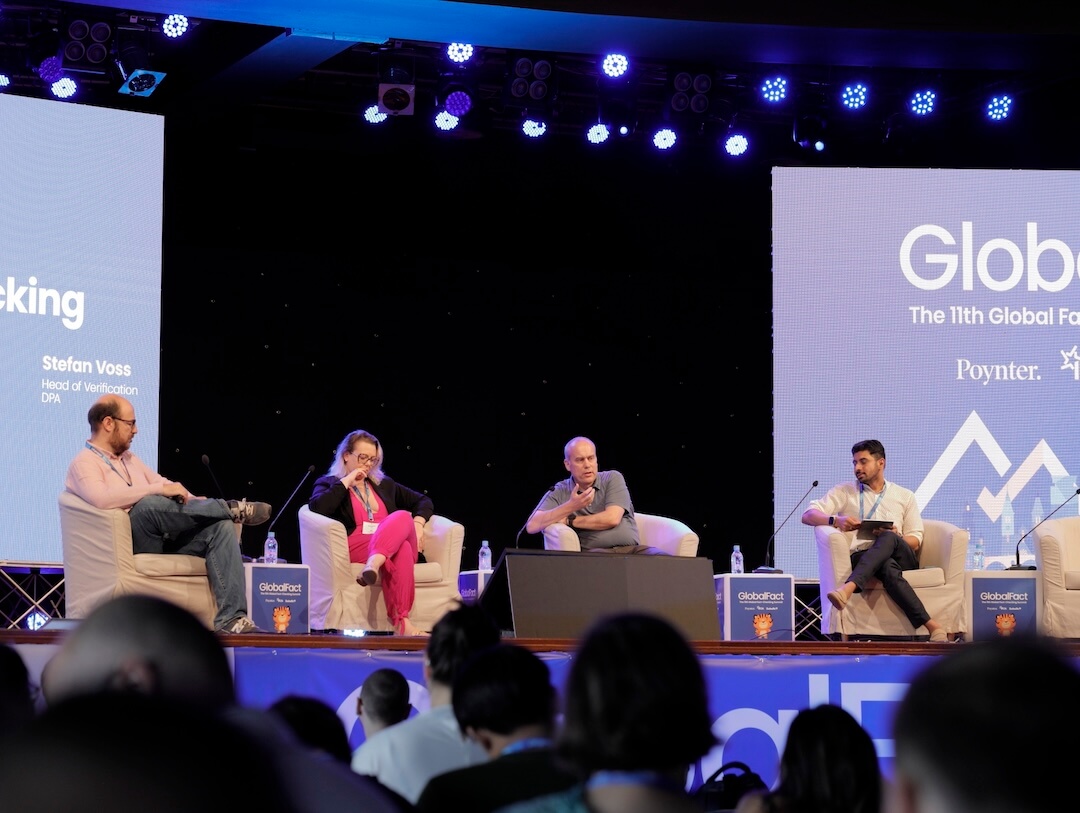SARAJEVO, Bosnia and Herzegovina — Two years ago, fact-checkers from all over the world signed an open letter to YouTube with four solutions for reducing disinformation and misinformation on the platform.
As they convened this year at GlobalFact 11, the world’s largest annual fact-checking summit, fact-checkers agreed there has been no meaningful change.
Fact-checkers from Spain, Brazil, Germany and India spoke on a June 27 panel about YouTube misinformation in their countries and the lack of action to reduce these falsehoods.
European Fact-Checking Standards Network chair Carlos Hernández-Echevarría, who moderated the panel, said the panelists felt that YouTube’s user experience hasn’t changed since more than 80 fact-checking organizations published the open letter in 2022.
The four demands in that letter were: meaningful transparency, context on videos, action against repeat offenders and anti-misinformation efforts in languages other than English. In a critical year stacked with elections in several countries, fact-checkers found that these needs have gone unmet.
Newschecker founder Rajneil Kamath spoke about his experience in India, which has the world’s largest YouTube user base with 462 million users. The country’s 2024 election was even dubbed the “YouTube election.” Kamath said while YouTube was viewed by others as the “last bastion” of independent media, the platform hosted a lot of election misinformation.
YouTube’s removal policy covers content that “poses a serious risk of egregious harm.” Kamath said one channel that constantly peddled misinformation was brought to YouTube’s attention late last year but the platform only acted in March, not long before the election.
The channel continued to publish livestreams with falsehoods and racked up hundreds of thousands of views, Kamath said.
“Now, does it cause real-world, egregious harm?” Kamath said. “No, it probably doesn’t, not at that instance. But what does it do? It reduces trust in institutions. It reduces your faith in democracy. It attacks individuals in many ways, and ultimately it’s potential physical harm. But at that instance, YouTube would do absolutely nothing. And it hasn’t changed.”
Support for other languages still needed
Lupa CEO Natália Leal has found minimal improvements to anti-misinformation measures in languages other than English. “No matter which country you are looking at, YouTube plays a central role in the consumption of news. And most of these countries are not native speakers of English,” she said.
In an interview with Poynter, Factchequeado co-founder and CEO Laura Zommer said there’s been no effort from YouTube to help Spanish speakers in the U.S. gain access to quality or reliable information. “If you start following, for example, an account, or you watch a video (saying) Biden opened the borders or Biden is bringing immigrants (by boat) illegally, you’re gonna receive tons of (those) videos,” she said. “That is happening now in one of the main elections of the world.”
When YouTube does present solutions, it focuses on English and doesn’t give a timeline for applying it to other languages, Leal said.
Earlier this month, YouTube announced that it was testing a feature that allows people to add notes providing context to videos, a measure that reminded fact-checkers of X’s Community Notes. This feature is being piloted only in the U.S. and in English.
“Many countries have already finished their elections, and we saw no intervention or support of this kind,” Kamath said.
Only those with an “active YouTube channel in good standing” are eligible to write these notes. Kamath’s organization, which has had its content taken down despite their appeals, would not be eligible.
Notes of this sort can also be problematic if the writer isn’t named, noted Deutsche Presse-Agentur head of verification Stefan Voss.
“We are certified. You can write us a mail if you are not happy with what we are writing,” Voss said. “We are showing our faces. This is how we should meet disinformation.”
Funding is good, but not enough
Voss noted that YouTube has taken at least one step: the Global Fact Check Fund, a $12-million grant Google and YouTube provided to verified signatories of the IFCN’s Code of Principles for initiatives that will help them grow their organizations. But he said fact-checkers may not be able to finance teams for these projects.
“We need the tech companies’ money. But part of the reason why we need that so much is because they are making the problem bigger and bigger,” Zommer said, citing how their algorithms tend to show content from disinformation actors more than debunks produced by fact-checkers.
Despite YouTube’s financial commitments, Hernández-Echevarría said, “many people, probably most people in the community, (are) not happy at all with how things are going.”
Voss said fact-checkers need to counter high-quality disinformation videos with their own videos. But producing video fact checks can be costly. In some instances when fact-checkers have done this, their efforts have not been rewarded, and sometimes have even been punished.
When searching for viral claims in Germany, Voss found that fact checks would sometimes appear at the top of the results page, but they got very few views. Kamath said when they published fact-check videos on YouTube, they were taken down because YouTube found they violated community guidelines.
System is ‘loaded against fact-checkers’
The system is loaded against fact-checkers, BOOM managing editor Jency Jacob said in an interview with Poynter. He said creators have the option to use opinion and sensationalism to promote their videos on YouTube, an option unavailable to fact-checkers.
“Fact-checkers cannot do it because we are limited by our own principles,” he said. “We cannot sensationalize the story.”
Compared to mainstream media organizations, Jacob said fact-checkers don’t have the resources to scale video production. Instead, he believes it is the platforms’ responsibility to push fact checks to the forefront.
Meanwhile, videos with misinformation often remain on the platform, Kamath said. But Leal pointed out that even when videos are removed, a lot of people may have already seen them. “We need transparency of data. We need to know how many people are consuming this type of content, but the measures, the actions, they should be more effective.”
Kamath said labeling is another solution long sought by fact-checkers: “It seems to me like the focus is either on removal or on free speech, when there’s very clearly a middle path which we fact-checkers have been trying to tell them for a very long time, which is labeling.”
Jacob cited the fact-check labels enabled by Meta’s third-party fact-checking program. “My dispute with YouTube has always been that they haven’t even given us that chance,” he said.
Zommer said the situation is critical because fact-checkers don’t have a point of contact when they encounter harmful and viral content during elections, social movements or health crises.
Hernández-Echevarría said they invited YouTube to join the panel but the tech company declined. At GlobalFact 9 in 2022, YouTube sent a representative who fielded criticism from fact-checkers. But in this year’s GlobalFact, as pointed out by Reuters digital verification editor Stephanie Burnett during the Q&A, that seat was missing.







